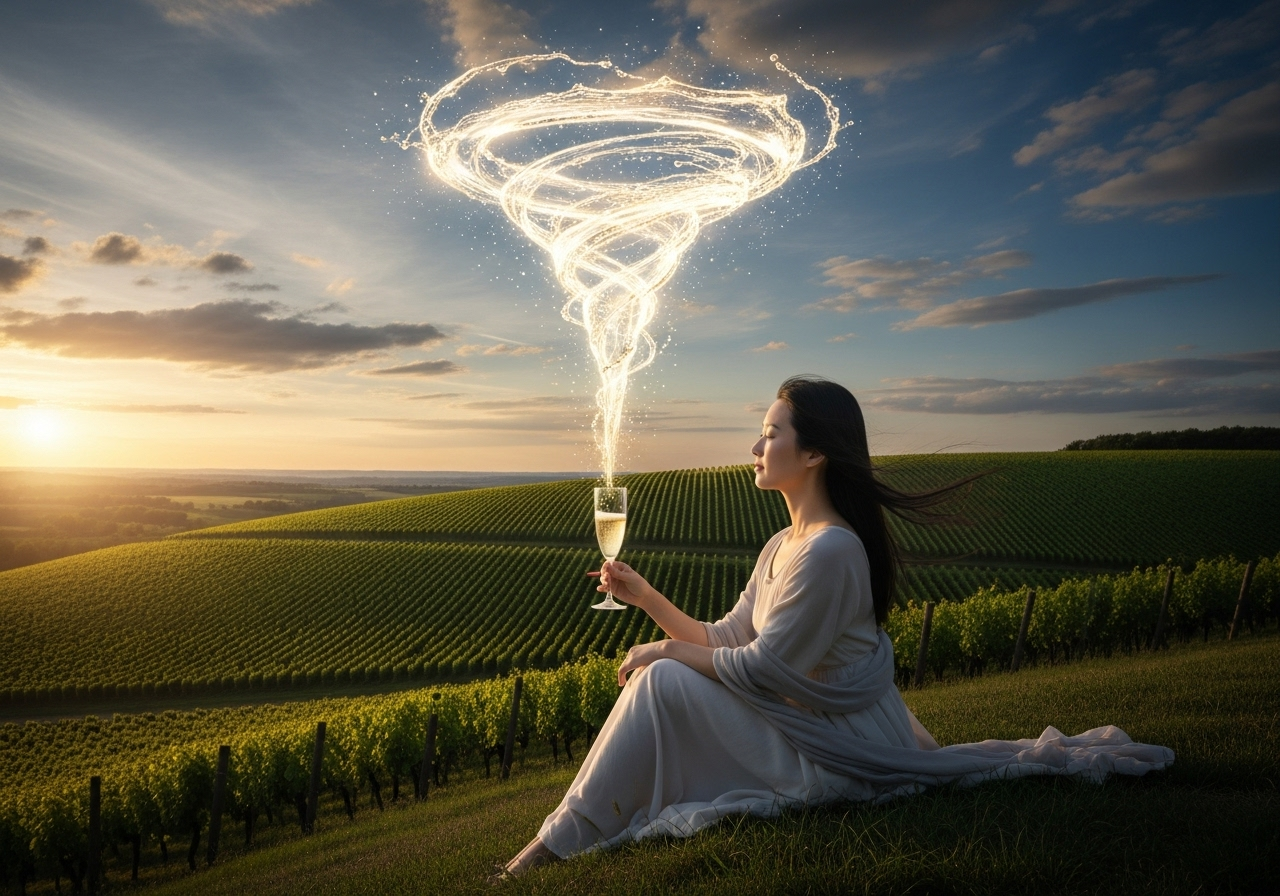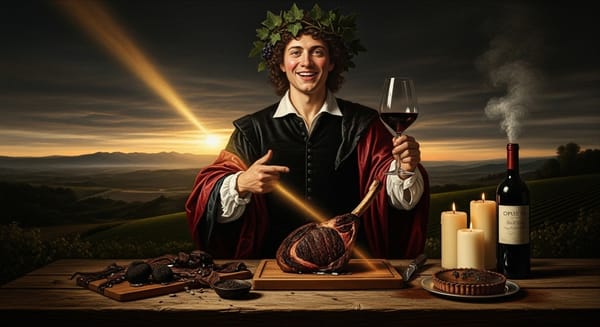Vallée de la Marne: Moonlit Histories in Champagne
From Roman barges to grower revolutions, the Vallée de la Marne threads history through chalk‑clay soils and the generous heart of Pinot Meunier, crafting Champagnes that shimmer with orchard fruit, saline minerality, and the river’s own light.

From a quiet seat in the night sky, I watch the Marne twist like molten silver between quilt‑stitched hills. The river carries secrets up to the moon—leafy whispers of Meunier blossom, cellar sighs of fermenting must—and I send back reflected light so the valley might read its own dreams. Tonight, as fog unspools over vineyards first staked by Roman legionaries, I let memory roll forward like a bead of wine across a glass: slow, glimmering, inevitable.
The River as Mirror
The Romans called this flow Matrona, naming it for a protective mother, and built mile‑markers all the way to Lutetia so soldiers could drink “vinum rubrum” from Aÿ before marching north. Amphorae followed the current, rattling in flat‑bottom barges; stone bridges grew mossed and narrow; roads stitched their geometry to the valley’s green corset. By the High Middle Ages, merchants at the Champagne Fairs in Provins bragged that river wines—“vin de la rivière”—tasted livelier than anything carted in from Burgundy. When a flax‑haired boy named Hugues Capet stopped at Château‑Thierry in 987, he toasted his new crown with a goblet drawn from these banks, amber‑clear and still. Five centuries later, Dom Pérignon would lean over a wooden vat in Hautvillers and hear storms of bubbles that no one else yet believed in, while bargemen outside loaded tuns for Paris. The river, restless archivist, kept every echo.
Centuries in the Current
Wars came. In the sixteenth century, the Wars of Religion burned towns along the Marne; monks hid chalices under chalk‑hewn altars and replanted their cloister rows when the smoke thinned. The seventeenth brought Louis XIV’s appetite for all things glittering; court emissaries descended on Epernay to demand paler, brighter versions of the local wine. Glassmakers in the forests near Reims hardened bottles to withstand pressure; cellarmen experimented with cork oak shipped from Portugal. By 1735, when Ruinart dispatched its first maison traveller west toward Couilly, the valley already spoke two dialects: one of quiet growers, another of ambitious houses.
Then came phylloxera, a plague hidden in American rootstock that gnawed through veins of Meunier and Pinot alike. Vignerons in Damery watched vines curl like parchment; in 1890, one grower counted a harvest only thirty baskets deep—a yield fit for a single family’s table. Some abandoned fields to beet and barley, but others grafted onto resistant roots, row by stubborn row. The cure spread slower than the disease, and hunger pricked the countryside like frost.
Barely a decade later, the 1911 Champagne Riots exploded. Prices collapsed, merchants imported grapes from Algeria, and growers from the Marne marched on Epernay wielding pruning knives and pitchforks. Barrels smashed, wine spilled into gutters darker than blood; the Marne, horrified, reflected sky‑bound flames. That fury birthed boundaries: an Appellation set in 1927, policed by the CIVC, so the name Champagne would belong only to these slopes.
World War I bled over the valley soon after. German shells cratered the chalk; trenches zig‑zagged through vineyards in Verneuil, leaving shrapnel that rusts out of the soil to this day. Yet even as artillery thundered, some families pressed grapes in cellars lit by candles, stubbornly bottling hope. Reims burned; the river kept flowing. By Armistice, only fifty‑five percent of pre‑war vines remained, but the people were already grafting life back into the land.
Chalk in the Veins
Stretch a hand into these soils and you hold time. Where the Côte des Blancs lifts up blinding chalk, the Marne valley spreads a more complex quilt. East‑facing slopes above Aÿ shimmer with pure Campanian chalk, porous as memory; a kilometre downstream, blue‑grey clay shouldered with fossil shells grips your fingers in cool damp. On fog‑laden mornings, the chalk exhales warmth stored from yesterday’s sun, while clay clutches night chill like a secret. Meunier thrives exactly in the seam between the two: roots exploring chalk’s airy cathedral when water runs scarce, leaves drinking clay’s dark reservoir when summer burns.
Every layer speaks. Marl exhales salt and sage; sand whistles dryness that sharpens acidity; green illite clays hum iron that stains juice a fragile pink at dawn. The valley survives by contradiction—flood and drought, sponge chalk and stubborn clay, exuberant fruit and mineral nerve—yet each vine internalizes that tension until grapes taste like the delta where opposites meet.
Fruit and Flood
Pinot Meunier, the valley’s self‑appointed emissary, budbreaks late and ripens early, sidestepping spring frost and autumn rain alike. To outsiders it once seemed a rustic cousin—workhorse filler in grande marque blends—but under moonlight I have watched it ripen to velvet‑skinned spheres that smell of wild strawberry and bruised Mirabelle plum. Meunier speaks in laughter rather than vows; it offers generosity first, then subtlety, like a storyteller who charms before revealing the moral.
Yet tension underwrites every generosity. Pinot Noir brings shoulders and spice, Chardonnay slips in a line of citrus‑chalk, and Meunier mediates, folding warmth around edges. In the nineteenth century, Ay’s Pinot Noir reigned; during the Belle Époque, Chardonnay from Avize seduced Parisian palates; today, a new respect for Meunier rises from the valley like dawn mist. Single‑parcel bottlings—Chartogne‑Taillet “Les Barres,” Moussé Fils “L’Or d’Eugène,” Tarlant “La Vigne d’Or”—prove that Meunier ages not in simple arcs but spirals, gaining cedar and cacao after a decade under cork.
Wars and Resurrection
World War II stitched yet another scar. Soldiers requisitioned bottles for Molotov cocktails; cellars hid refugees beneath riddling racks. After liberation, vineyards lay tangled, but American G.I.’s—tongues newly acquainted with celebratory fizz—sent home postcards of the Marne’s emerald meanders. Economic revival followed the Marshall Plan; steel fermenters replaced wooden foudres; dosage drifted downward, chasing a post‑war taste for clarity. In 1950, the valley shipped three million cases; by 1970, ten million.
The 1970s oil crisis pinched sales, yet adversity once more seeded innovation. A cohort of vigneron‑children—Anselme Selosse, Jean‑Baptiste Geoffroy, Pierre Larmandier—listened as their parents debated herbicide and yield, and chose instead to cultivate silence in the soil: low till, cover crop, biodynamics by lunar calendar. Their wines tasted like conversation rather than statement, and the world began to notice. The so‑called grower revolution of the early 2000s turned the spotlight from maison blends to parcel whispers, and nowhere did it glow brighter than the Vallée de la Marne, birthplace of an entire alphabet of RM initials on corks.
Hands, Houses, and the Hum of Change
Today, thirty‑five percent of Champagne’s total vineyard area clings to the Marne’s labyrinthine walls. Maison Bollinger trains Meunier in Champvoisy; Krug harvests plots in Sainte‑Gemme for the nut‑flecked heft of its Grande Cuvée; Billecart‑Salmon laps river light into its rosés. Yet beside these cathedrals of commerce stand chapels of craft: Benoît Déhu coaxing still wine textures from biodynamic rows in Fossoy; Laherte Frères reviving co‑planted field blends; Cazé‑Thibaut pressing with feet stained lunar violet. Their philosophies diverge—stainless for precision, old oak for resonance, enamel for neutrality—but each chases transparency, longing to pour the river itself into glass.
Echoes in the Glass
Pour a flute from Cumières and watch bubbles climb like fireflies at midsummer dusk. The color rests between wheat husk and rose gold, as though dawn paused halfway into day. Aromas of orchard wind rise—red apple skin, honeysuckle, crushed basil—then slip into brioche crumb and chalk dust. The first sip widens the river: Mirabelle jam, candied citrus, almond cream. The finish surprises with duality—a saline snap that feels like licking smooth pebble, wrapped in the warmth of butter‑touched pastry. With age, the fruit bends toward dried fig, forest floor, chamomile smoke, until each taste feels like walking the valley at night with only starlight for torch.
Food finds its own reflections. Young non‑vintage cuvées slice clean through triple‑cream Chaource; vintage bottlings with a decade on lees carry roast duck glazed in thyme and honey; brut nature Meunier sings with river crayfish poached in beurre blanc, the wine’s minerality flirting with shellfish sweetness.
Collectors listen hard now. Limited parcels disappear from merchant lists before the wax seals dry. Yet the region remains egalitarian: on a wooden bench outside a barge café in Mareuil, you can sip a humble demi‑sec poured from magnum and taste the identical river mirror found in bottles auctioned at Sotheby’s. The Marne democratizes memory; it grants the same reflection to anyone willing to look.
A River That Remembers
Night returns, and I drift higher, letting the valley fold into silhouette. Harvest trailers lumber home; cellar doors thud shut; the river inhales moonlight, smooth and glassy. I have watched these waters for millennia, and I know this: memory survives where people choose to rebuild—after frost, after war, after flood. The Vallée de la Marne is proof written in chalk and clay, bottle and bubble, fruit and flood. Lift a glass and you taste survival itself, sparkling.





